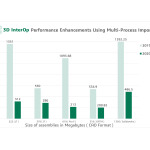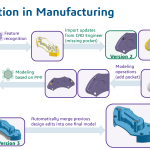Delivering enhancements across the Spatial product offering, enhancing the workflows of targeted industries
BROOMFIELD, Colo.–(BUSINESS WIRE)–Spatial Corp, the leading provider of 3D software development toolkits for design, manufacturing, and engineering solutions, and a subsidiary of Dassault Systèmes, announces today the production release of 2020 1.0, delivering the ability of application developers to more tightly couple CAD with simulation, as well as enhancing user experience by increasing the responsiveness of applications when selecting geometries or importing large assemblies.
This release of the powerful 3D Core Modeler adds more tools to further automate manufacturing processes, enabling application developers to deliver cutting-edge manufacturing solutions.
Best-in-Class Morphing Operator
To enable simulation-driven modeling and design optimization, this release of CGM Core Modeler includes support for smooth BRep geometry morphing. Built using the smooth displacement adjustment (SDA) method, this operator allows geometry morphing given an input displacement vector field. Thus, CAM systems can implement tooling and design compensations based on shrinkage or springback simulation, or CAE or CFD systems can implement design optimization algorithms where simulation automatically drives CAD changes.
The result is that CAE, CFD and CAM systems can easily include simulation results back into their original smooth BRep CAD design.
Pre-Processing for Manufacturing
This release also includes a geometry pre-processing tool to improve the automation of additive manufacturing workflows, complementing existing functionality such as automated healing to provide a complete solution for additive manufacturing applications. Some of these new features include:
- Nesting and instancing operators based on constraint solving heuristics to enable manufacturing at scale
- Automatic part orientation based on support volume minimization algorithms to optimize material usage
Automate Manufacturing Processes
Additional functionality in this release enables automation in manufacturing processes to reduce design cycles and eliminate the associated human errors. Features include:
- Semantic information extraction from manufacturing annotations including symbolic and cosmetic threads, letting the CAD drive manufacturing
- CAD Associativity, enabling automatic updates downstream when the source design changes
- Feature recognition and Defeaturing, allowing automatic identification and extraction of parameters from features like holes, fillets, or pockets, as well as their removal.
- Direct Editing, enabling one-step edit of geometry while maintaining associated features like fillets and holes
Faster picking of spline faces
Used to enable geometry selection, efficient ray firing capability is an essential first step for many downstream geometry operations. The ACIS 2020 1.0 release includes performance enhancements to the api_ray_fire API, resulting in tremendous performance gains. For example, a ray firing computation across 21 spline faces that previously took 533 seconds, now takes only 14 seconds.
Enhanced Import Performance
A major performance bottleneck in many workflows is the import of large CAD assemblies. This release of 3D InterOp delivers 100% improvement in performance by enabling multi-process CAD import across all formats and product lines including CATIA. Application developers can leverage this new capability to:
- Parallelize the import of sub-components of CAD assemblies
- Improve application responsiveness by keeping the application’s main process free for other tasks
- Selectively import a sub-section of the entire product structure, thus enabling users to perform quick and easy reviews
All of these enhancements greatly improve user experience by enabling a more responsive application during the import process.
About Spatial
Spatial Corp, a Dassault Systèmes subsidiary, is the leading provider of 3D software development toolkits for technical applications across a broad range of industries. Spatial 3D modeling, 3D visualization, and CAD translation software development toolkits help application developers deliver market-leading products, maintain focus on core competencies, and reduce time-to-market. For over 30 years, Spatial’s 3D software development toolkits have been adopted by many of the world’s most recognized software developers, manufacturers, research institutes, and universities. Headquartered in Broomfield, Colorado, Spatial has offices in the USA, Germany, Japan, China, and the United Kingdom. For more information, visit www.spatial.com.
Contacts
Spatial Corp. Press Contact
Omar-Pierre Soubra
+1 720 445 6627
omar.soubra@3ds.com












































